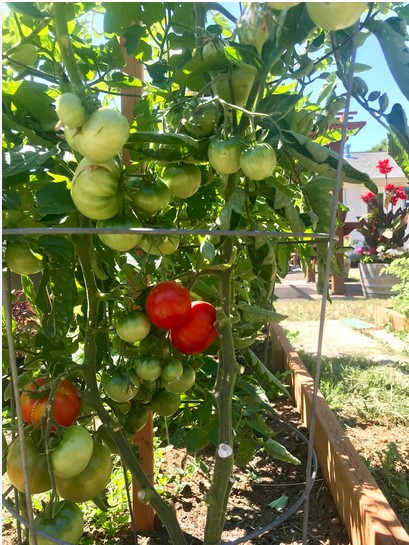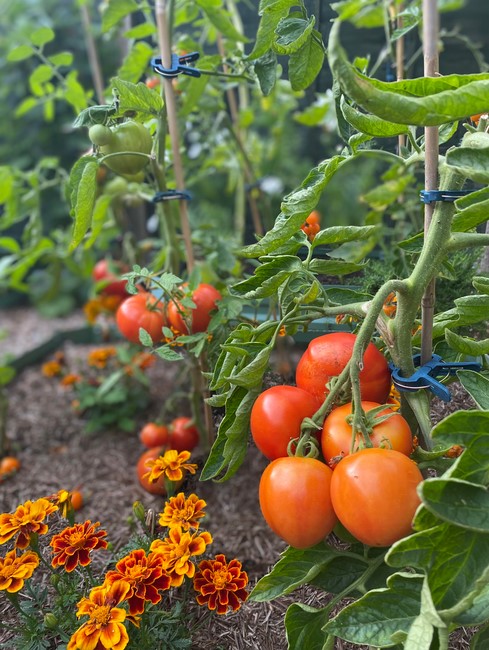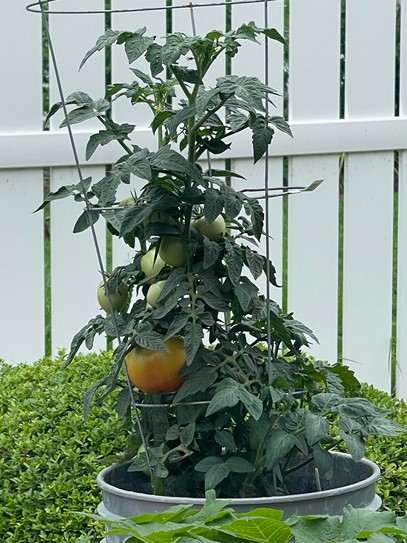Watching your tomato plants thrive and produce a bountiful harvest till fruit production comes to an end is a satisfying process to watch. If you’re one of those who savors this pleasure, then knowing when tomato plants cease fruit production is of utmost importance.
In this detailed write-up, we’ll explore the various reasons behind the end of tomato production and will also take you through the necessary steps to extend the harvest season.
So, take a deep dive and determine when the tomato plants are ready to end their life cycle.
How Long Does The Tomato Plant Continue To Bear Fruit?
Table of Contents
Tomato plants produce fruit for 6-8 months at a stretch. However, the production of tomato plants depends on many factors, as they consist of two different varieties: determinate and indeterminate. These two tomato varieties have entirely different production patterns.
Tomato Fruit Production Timeline
Below is a complete breakdown of the tomato fruit production timeline:
Germination (5-10 Days)
Seedling Stage (2-3 Weeks)
Vegetative Growth (4-6 Weeks)
Flowering Stage (1-2 Weeks)
Fruit Development (2-4 Weeks)
Ripening Stage (1-2 Weeks)
Harvesting Stage (Varies By Variety)
1. Determinate Varieties
Determinate tomato varieties have an entirely different growth pattern as compared to the indeterminate ones. They grow for a comparatively shorter period and focus mainly on fruit production and also have a different life cycle.
Determinate tomato varieties have bush-like structures that usually grow between 2-4 feet. Their compact, bushy growth habits make them an ideal choice for gardeners who have a space crunch.
In their relatively short time frame, the plant solely focuses on flowering and fruiting. The fruits tend to ripen over 2-4 weeks and cease their growth and fruit production after the initial harvest.
They need minimal maintenance and staking or caging due to their minimal growth. Determinate varieties are great because of their short growing season and are known to provide a reliable harvest within that time frame.
Roma, Celebrity, Patio Princess, and Rutgers are some examples of determinate tomato varieties, and the total time taken by them for harvest is around 70-85 days.
2. Indeterminate Varieties
The indeterminate tomato varieties are also called vining tomatoes. They are known for their continuous growth and fruit production.
Indeterminate tomato varieties grow for an indefinite period and are known to supply fresh tomatoes continuously for months. They grow to a height of about 6-10 feet and keep on expanding.
They need proper support in the form of stakes, cages, or trellises spread across the ground and are more susceptible to pests and diseases. Indeterminate tomatoes are also known to bear fruits continuously throughout the growing season and hence ensure a steady supply of fruits over an extended period.
Indeterminate tomato varieties have a comparatively slower ripening process. Their lifespan is longer than that of determinate varieties. For thriving, indeterminate tomato varieties need proper maintenance, regular pruning, a sturdy support system, and balanced fertilization techniques.
Beefsteak, Cherokee Purple, Sungold, and Brandywine are some examples of indeterminate tomato varieties that take 75-90 days to harvest.
Factors Affecting The Fruit-Bearing Of Tomato Plants

The fruit-bearing capabilities of a tomato plant are influenced by a wide variety of factors.
Some of the key factors that affect tomato fruit production are discussed below:
- Temperature
- Pollination
- Nutrients Availability
- Watering Practices
- Growing Conditions
- Pruning and Maintenance
- Light Availability
- Disease And Pest
- Plant Variety
Signs A Tomato Plant Is Nearing The End Of Its Fruit-Bearing Period

As the tomato plant approaches the end of its fruit-bearing period, it starts displaying certain signs that call for immediate harvesting of the remaining tomatoes.
Look for these telltale signs:
1. Reduced Flowering And Fruiting
An aging plant stops producing new flowers, which clearly indicates that there is very little or no opportunity at all for fruit production. This reduced flowering or fruiting mainly happens because the plant diverts its complete energy towards the ripening of the fruits rather than producing new ones.
This noticeable reduction in flower production is a clear indication that the fruiting phase of the plant is winding down.
2. Yellowing And Wilting Of Leaves
The yellowing, wilting, or dropping of leaves is another indication and is a natural sign of aging. During this phase, the plant isn’t bothered to utilize the remaining energy on foliage maintenance, instead, it diverts the complete energy towards fruit ripening.
Particularly the lower leaves of the plant turn yellow or brittle and can even fall off as they approach the end of the fruiting season.
3. Slower Or Stunted Growth
Slower or stunted growth signals the end of the fruiting phase and is a clear indication that the plant has directed all its energy on the ripening of the fruits instead of focusing on its growth.
At this juncture, the plant ceases growth and also stops expanding its branches. It shifts its priority towards maturing its fruit and redirects its entire energy towards ripening the existing fruits.
Also, no signs of new growth or lack of growth is another noticeable sign that the plant has approached its fruit-bearing period.
4. Overripening Or Rotting
Once the tomato plant nears the end of its fruit-bearing period, it’ll display certain signs or noticeable changes such as over-ripening or rotting of the fruits.
It is also noteworthy to mention that the metabolic process of the plant also slows down to a significant level, which in turn will affect fruit production.
Also, the slower metabolism disrupts the ability of the plants to regulate the moisture and sugar content in the fruits, thereby leading to splitting or overripening.
Aging plants fail to deal with the environmental stresses that in turn accelerate the overripening or rotting.
5. Lack Of New Fruit
The plants are known to stop producing new fruits as they move towards the end of their fruit-bearing season. This generally happens as it no longer directs its energy or resources toward the production of new fruits.
Therefore, the lack of new fruit production is a clear indication that the tomato plant has reached its natural end.
6. Decreased Foliage Growth
The tomato plants also show signs of a noticeable reduction in the size or the number of leaves, thereby indicating that the plant is nearing the fruit-bearing stage.
This significant reduction in the growth of new leaves and the falling of the existing leaves indicates the end of their vegetative growth.
7. Increased Susceptibility To Pests And Diseases
As the plants age, they become more prone to pests and several bacterial or fungal infections. With time and age, the natural defense mechanism of the plants weakens, and their resistance slowly drops, so it becomes difficult for them to protect themselves from pests and diseases.
Read through this guide and find out Which Creatures Are Devouring My Mature Tomatoes In The Garden?
8. Slower Fruit Ripening
Fruits may generally take a little longer than the usual time frame, and their size or quality may also decline significantly. Due to aging, the plant’s energy decreases over time and thereby impacts its ability to nourish and develop the fruits.
Also, the significant delay in the ripening of the fruits or uneven ripening patterns is due to the natural part of the plant’s aging process. Also, the production of ethylene decreases significantly, thereby leading to slow or incomplete ripening of the fruits.
9. Broken Or Weak Stems
Broken, weak, or thin stems signal that the plant is nearing its fruit-bearing cycle and doesn’t have the required resources to maintain strong stems.
During this phase, the stems weaken or get broken, indicating a significant transition from its peak production phase and nearing the end of the season.
10. Lack Of New Growth
When the plant ultimately stops producing new shoots or branches, it devotes its entire resources towards the ripening of the existing fruits rather than concentrating on the expansion of the plant itself.
It also shows signs of slowing down instead of extending its branches. This lack of new growth indicates that the plant has finally entered the last stage of its life cycle and hence is winding up its growth phase, so instead of continuing the vegetative development, it is focusing its entire energy on fruit ripening.
Best Practices To Extend The Fruit-Bearing Period

Want to enjoy a bumper crop of delicious, homegrown tomatoes? All you need to do is maximize the yield of tomato plants by following these effective tips:
1. Select high-yielding tomato varieties
2. Preparing well-drained, nutrient-rich soil
3. Planting at the appropriate time
4. Provide shade during extreme heat
5. Optimize temperature and humidity
6. Provide adequate spacing
7. Removing damaged or old fruits
8. Consistent and regular watering practices
9. Using a balanced fertilizer
10. Supporting the plants with stakes, cages, or trellises
11. Pruning and removing suckers
12. Applying a layer of mulch around the plants
13. Monitoring for pests and diseases
14. Harvesting frequently
Bottomline
So, taking time and understanding the signs of ending the fruit-bearing cycle of tomato plants will help you to make the most of the remaining fruits.
Monitor those signs closely and harvest the best possible yield before the plants completely stop producing the tomatoes.
Leave a Reply